Acne
Dr Mike Wyndham is a GP in a suburban practice in Edgware Middlesex. He has always been a keen photo...
Dr Mike Wyndham is a GP in a suburban practice in Edgware Middlesex. He has always been a keen photographer, and has been taking medical photographs for more than 25 years. He has been a regular contributor to the GP press and his work has also appeared in the British Medical Journal, The Pharmaceutical Journal and various medical text books
As with most skin conditions, acne is associated with significant psychological morbidity, and no matter how mildly affected the patient appears to be, their condition needs to be taken seriously and treated appropriately. Updated December 2019
SIDE EFFECTS OF ISOTRETINOIN
Isotretinoin is the most effective treatment for acne. It reduces sebum production, is anti-inflammatory and reduces the bacteria associated with the condition – Propionibacterium acnes. It is used for the severe forms of acne, such as nodulo-cystic form, and where the condition has not responded to standard antibiotic therapy. The medication can only be prescribed under the supervision of a consultant dermatologist and the course lasts 16 weeks. Isotretinoin is teratogenic and so women of child-bearing age need to ensure that they do not get pregnant. They must use at least one method of contraception if not two. The progestogen only pill is not considered to be a safe method. The side-effect profile is significant and includes drying of mucous membranes (hence the dry, cracked lips shown here), joint and muscle aches, raised liver function enzymes, raised lipids (cholesterol and triglycerides), neutropenia, thrombocytopenia. There is no causal link with depression but it is important to warn the patient that there may possibly be an association and to get help if they experience any mood disturbance.
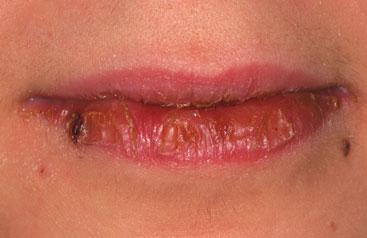
POLYCYSTIC OVARIES
Acne may form part of a group of symptoms indicative of polycystic ovaries. Others include oligomenorrhoea, hirsutism and weight gain. In any woman who presents with acne, it is useful to enquire if any of the other symptoms are present. While this may not influence the treatment you give for acne, which should follow the standard pathways, it may highlight an underlying problem that requires attention. Dianette (cyproterone acetate/ethinyloestradiol) has anti-androgenic properties and may be helpful in women who suffer from acne or hirsutism and who also require oral contraception
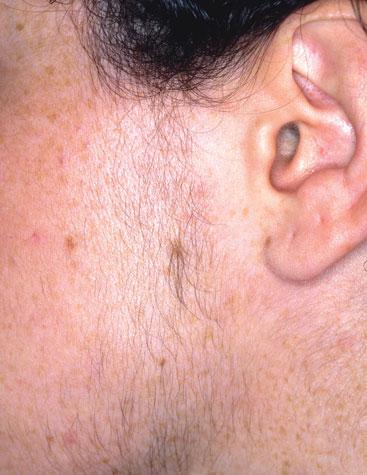
MINOCYCLINE PIGMENTATION
If response to topical preparations alone is inadequate, consider adding an oral antibiotic such as lymecycline or doxycycline, for a maximum of 3 months. a topical retinoid or benzoyl peroxide should always be co-prescribed to reduce the risk of antibiotic resistance developing. Macrolide antibiotics such as erythromycin should generally be avoided due to high levels of P. acnes resistance. Minocycline is not recommended as it may be associated with pigmentation (as shown on the tongue, here), cause a systemic lupus erythrematosis (SLE)-type syndrome, and upset the liver.

MODERATE ACNE
Spots caused by acne may be closed i.e. whiteheads, which are small papules with a white appearance or open i.e. blackheads. The latter are formed as a result of skin pores being blocked with keratin. The papules may develop an inflammatory response, which may ultimately become pustular or even cystic. Spots are classically distributed in areas of the skin that have a high level of sebaceous glands, for example, the face, chest and back. As with many skin diseases, there is significant psychological morbidity and all patients should be taken seriously no matter how mild the appearance of the skin may appear.
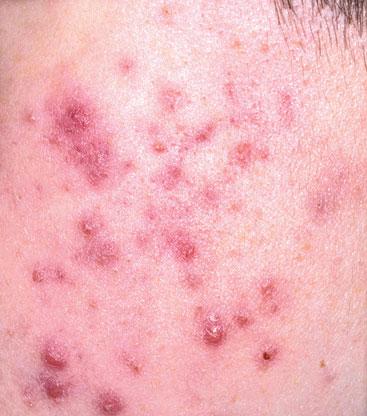
POST-INFLAMMATORY HYPERPIGMENTATION
It is not clear why the body will respond with increased pigmentation after an inflammatory skin condition but it is possibly a type of protective mechanism while the skin is healing. It is easy to see that the patches correspond to where there has been an original problem, such as spots of acne. The pigmentation may fade with time but it is possible that it may not clear at all. There is no real treatment that will deal with the condition effectively. The best treatment is to adequately treat the acne in the first instance.
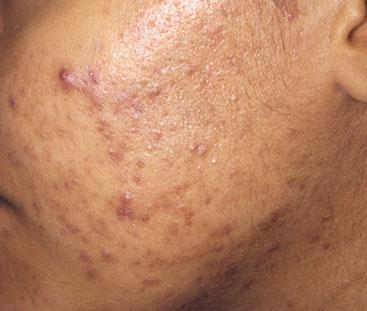
SCARRING (ICE PICK)
Scarring may be atrophic, ice pick or hypertrophic. Nodulo-cystic acne is more likely to leave scarring but even mild acne may cause the problem. Squeezing and picking may lead to scarring and should be discouraged. Scarring may be treated with dermabrasion and is more effective when the scarring is above the skin. Lasers may also have a role in treatment.
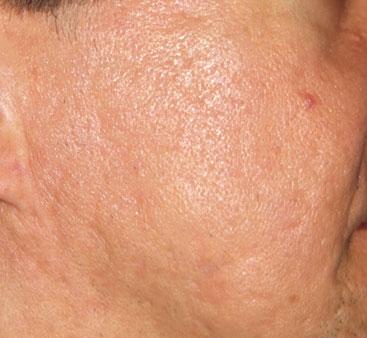
Related articles
View all Articles